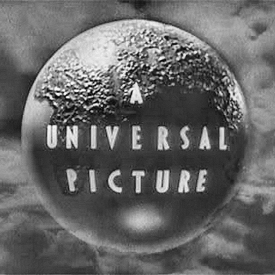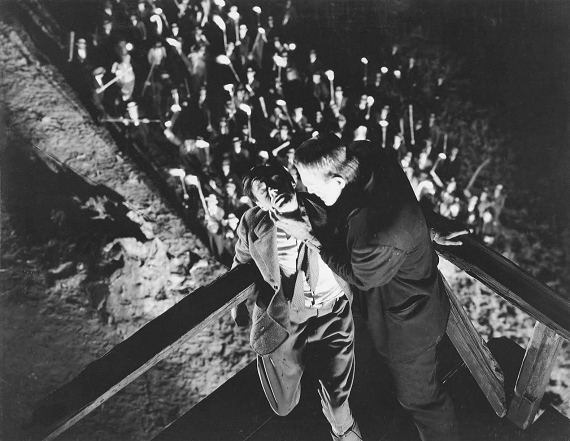
Since most of us are fans of genre movies, I thought maybe it was time to go back to our roots, so to speak. Yes, I’m aware Thomas Edison’s company made an earlier Frankenstein in 1910, starring Augustus Phillips as Dr. Frankenstein, and Charles Ogle as The Monster. (The link should take you to the full movie on YouTube—just about 12 minutes’ worth.) Those of us who read Forrest J Ackerman’s Famous Monsters of Filmland (of course, there were competing “monster mags,” but FM was the “big daddy”!) were intimately familiar with the one or two stills that Forry posted often from that film, but few have, until recently, seen the whole thing. The special effects were good for their time, but borrowed all their techniques—stop-film, reverse film, etc.—from the Georges Méliès films of almost a decade earlier.
But 1931 saw the release of Universal Studios’ two classic horror films; ones that defined the genre—I refer, of course, to the Carl Laemmle-produced Frankenstein, directed by James Whale; and Dracula, helmed by Tod Browning (to be followed in 1932 by Karloff’s second iconic role, The Mummy, directed by Karl Freund). Interestingly enough, the first release was Browning’s Dracula, and its success paved the way for Whale’s production of Peggy Webling’s stage play adaptation of Mary Wollstonecraft Shelley’s tale. By today, almost everyone, in the Western world at least, is somewhat familiar with both movies—at least the monsters (Dracula and Frankenstein’s creation), or the images of both Bela Lugosi and Boris Karloff as the two; but in those days only a small portion of the public had read either book. Of course, most of the movie-going public now confuses the scientist Frankenstein with his creation.

I suppose a quick rehash of the story—not spoiler-free, by the way—would be in order at this point, although I will have a tough time not confusing this storyline with that of Young Frankenstein, the brilliant parody by Mel Brooks, which starred Gene Wilder, Marty Feldman, Peter Boyle, Madeline Kahn, Teri Garr and Cloris Leachman as the main characters. If you’ve never seen it you owe it to yourself—but I digress.

Henry Frankenstein (not Victor) (Colin Clive), son of the Baron Frankenstein, has studied both electrical science and medicine, and wants to combine the two; he returns to his family home in Europe (probably Germany) with his bride-to-be, Elizabeth Lavenza (Mae Clarke)*. (By the way, as I understand it, Frankenstein is the family name, the “von” is an honorific given to barons. So Henry wouldn’t be “von Frankenstein” until his father dies and he inherits the baronetcy.) He secludes himself in an abandoned tower to continue his experiments with bringing life back to dead flesh; he and his assistant Fritz (not Igor or even Eye-gor!) (Dwight Frye) are stealing fresh corpses from which he selects choice bits to stitch together as one gigantic human being—because of the state of this nascent science and the relative crudeness of the tools available, a large body is easier to work with. Fritz, a very agile hunchback, is sent to steal a brain, but steals a criminal brain instead of the one he has been sent to get. (Young Frankenstein: “Whose brain did you get, Eye-gor?” “Abby-something.””Abby who?””Um, Abby Normal, I think.”)

The creation is brought to life (Figure 4—we see Jack Pierce’s iconic makeup for the first time) and, through a series of mishaps, most precipitated by Fritz, is presumed to be evil, and imprisoned—but Fritz goes into the cell and torments him with fire until, enraged, the creation—now officially a “monster”—kills Fritz. Frankenstein and Dr. Waldman (Edward Van Sloan), who was brought in by Frankenstein’s fiancee, Elizabeth, in an attempt to get him out of his seclusion in the tower, hear Fritz’s shrieks and knock the monster out with an injection. Frankenstein leaves to help with the wedding preparations, leaving Dr. Waldman alone to deal with the monster, but the monster revives and kills Dr. Waldman, then escapes into the forest. Still an innocent, now that the rage has dissipated, the monster meets a young girl, Maria (Marilyn Harris), and learns a game with her: throwing flowers into the river. When they run out of flowers, Maria asks him, “What shall we throw now?” with predictable results.

While preparations for Henry’s and Elizabeth’s wedding are being made, Dr. Waldman’s body is discovered, and Henry rushes off to the tower; while he is gone, the monster sees Elizabeth through a window, dressed in her wedding finery. He breaks in and, we assume, strangles her. Meanwhile, Maria’s father appears in the town square, interrupting the village’s wedding festivities, carrying her lifeless body; the villagers all grab their torches, rakes and pitchforks and gather at the Mayor’s office. Henry, the upper-caste men and the villagers all form different mobs to go hunt down the monster. (Your traditional mob with the torches and baying dogs and so on; this was the first movie one, I believe.) Henry becomes separated from the others and the monster, coming upon him, knocks him out and carries him off. He (the monster) finds an abandoned windmill and carries Henry inside.

The angry villagers surround the mill and set it on fire; meanwhile, the monster throws Henry off the mill; he is only saved when he hits the sail of the windmill, which cushions the shock. The mill burns to the ground and Henry is borne off to the Baronial mansion, where we learn that Elizabeth is still alive. They are reunited, and the Baron toasts the happy couple’s marriage and his hope for a grandson.
If you haven’t seen this particular movie, you’ve probably seen one of the many sequels and remakes that have been made over the last 84 years; this movie and several others (Dracula, The Mummy, The Wolfman) have formed the core of Universal Studios’ “Classic Monsters,” and have been shown and reshown on television hundreds of times, so I hope you’ll forgive the spoilers above. Normally, I try not to include spoilers—or at least to warn you of them—but I think almost everyone is, or should be, aware of this movie by now!
In fact, in 1930, Universal was in big trouble, financially, having lost over two million dollars (and in today’s terms that would have been big, big money)—and Dracula, released the same year as Frankenstein, sold 50,000 tickets in 48 hours, becoming the most profitable of all its 1931 releases to the tune of $700,000 (according to Wikipedia). And in 1931, audiences were not yet jaded by too many monster movies or too many bad special effects. Carl Laemmle, Jr. was then the head of production and, seeing the writing on the wall, immediately announced that Universal would be doing more monster movies, thus spawning an industry that hasn’t yet slowed down. Besides the Universal monster movies—and each one named above has spawned a number of sequels and remakes—we’ve had any number of knock-off versions and, in the case of the British studio Hammer Films, another very successful franchise based on the same series of monsters, most notably Dracula, which gave us such notable actors as Christopher Lee and Peter Cushing.
So what is the popularity of this particular movie which, by the way, was intended more as allegory or (had the category existed when it was written) science fiction than “horror”? Is it the story, the setting, the actors, the makeup? Or is it, perhaps, the—not exactly unique to this film—message that “there are things Man was not meant to know? (A message that this writer vehemently disagrees with, by the way.) I think part of it is just about everything mentioned above, along with the cathartic power of a good horror movie; you can shiver in your seat, you can scream and/or clutch at your companion’s arm. You can close your eyes for the really scary bits, you can feel whatever degree of fear the film invokes in you—and when it is over, you can wend your way home safe and sound, with the monsters and things that go bump in the night somewhat mollified for the time being.
And tonight is Halloween; it is now arguably the biggest holiday in the United States these days, according to some accounts. Only Black Friday is bigger in terms of sales, I believe, and that may be only because bigger-ticket items are on sale then, while the majority of sales for Halloween are for candy, decorations and costumes.
Whatever floats your boat on Halloween, or when watching classic movies, I hope you have a chance to see a good copy of this film, and that you hand out—or receive, if that’s your thing—a lot of good candy and see a lot of cute costumes! Have a safe, happy Halloween, and if you’re driving, watch out for the little monsters!
*Okay, weird footnote #1: A movie released the same year as Frankenstein (1931) was to make Mae Clarke famous. I refer, of course, to The Public Enemy, starring James Cagney. This movie contains the well-known scene where Cagney pushes a grapefruit into Clarke’s face. If you haven’t seen the movie, you’ve probably heard of this scene. Until I started researching Frankenstein, I didn’t know it was the same Mae Clarke!
I really am interested in your opinion of this column, even if you didn’t like it. If you have anything to say about it, good or bad, please post your comment here—it’s easy, and you can even sign up to get automatic notifications of new columns! (I do publish corrections when you send me information, and even apologies if I got something egregiously wrong.) Or you could comment on Facebook; I post links every Friday when a new column comes out. My opinion is, as always, my own, and doesn’t necessarily reflect the views of Amazing Stories or its owners, editors, publishers or other bloggers. See you next week!











I very much enjoyed the post, Steve.
It’s odd that Frankenstein, released so soon after Dracula, is so far ahead of its predecessor visually. Whale seems to have imported German Expressionism and made that the way American horror movies were expected to look for quite some time.
Maybe the film does suggest that there are things man is not meant to know (which, as you imply, is a pretty ignorant philosophy when you think about it!), but it also keeps some of the real message of Shelley’s novel, i.e. that if you treat someone badly, they will do bad things. Perhaps that, and Karloff’s extraordinary performance in Jack Pierce’s make-up, are a large part of its enduring appeal.
The torch-bearing villagers in Frankenstein set a standard for villager mobs from then on, but you could argue that the mob that chases and catches Lon Chaney at the end of The Phantom of the Opera was the granddaddy of them all.